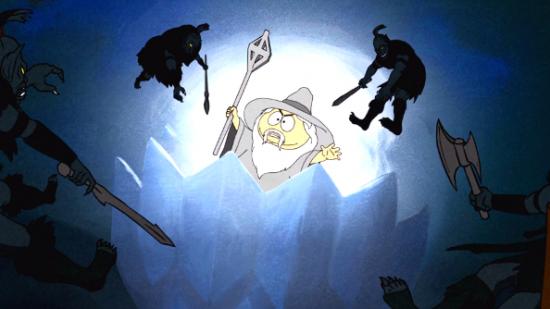I’ve been lugging around a bag filled with dildos and Christian rock CDs. Conveniently, it’s weightless. It didn’t get in the way when I had to spend hours hunting down a mythical beast for former American Vice President, Al Gore. Nor did it slow me down when I performed two abortions, both on men. It’s been an odd few days. But to expect anything less from South Park: The Stick of Truth is ridiculous.
Where other South Park games have utterly failed to capture the crude, offensive, absurdly entertaining spark that has kept the cartoon running for 16 years, The Stick of Truth succeeds utterly. Not only is it series creators Matt Stone and Trey Parker – who co-wrote the game – firing on all cylinders, it’s Obsidian’s most polished RPG. Not just a great South Park game, The Stick of Truth is simply a great game.
The Stick of Truth’s set-up draws on the season six episode “The Return of the Fellowship of the Ring to the Two Towers” and the three episode arc in the last season which started with “Black Friday”. South Park’s nine-year-old ne’er-do-wells are hosting an epic LARP. Two factions – Cartman’s KKK (Knights of Kupa Keep) and Kyle’s Drow – squabble and fight for control over the titular Stick of Truth, a gnarled sceptre which grants the owner control of the universe. At least in the imaginations of the South Park kids.
Thrust into this war is The New Kid, a mute newcomer to the little Colorado town and the game’s protagonist. The New Kid, or, as he becomes known, Douchebag, joins the KKK in their fight against the Drow as a mage, rogue, warrior or a Jew. Yes. A Jew. But beyond the comedy and unique South Park art style, the game starts off surprisingly traditionally.
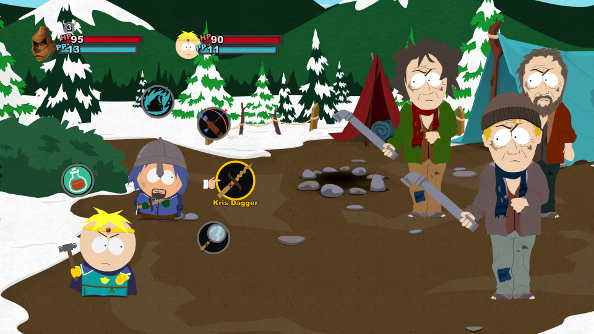
Learning how to fight is first on the cards, with the Wizard King Eric Cartman drip-feeding players his wisdom. It’s all very simple. On Douchebag’s turn he gets two actions. He can consume a potion to increase his strength, power (his special ability energy), speed and health, and then he can attack. Attacking straight away ends the turn, however. Of course, the potions are things like bags of cheesy poofs, tacos and assorted junk food.
During an attack, his weapon will gleam for a second, and that’s the time to choose what type of attack to employ: either a basic one, which is good at whittling down armour, or a powerful attack that does more damage. And when he’s attacked in turn, there’s another quick prompt, and if the button press is timed right, he blocks some of the damage.
Basic combat knowledge under his hat (or helmet), Douchbag can explore all of South Park. The town includes most of the show’s iconic locations, all presented perfectly. In fact, the entire game looks identical to an episode of the show. Many of the locations are hidden behind locked doors or other obstacles, though, waiting to reveal their secrets later on. But Douchebag can still break into houses, looting them clean, and continue his first few quests, most of which involve gathering missing members of the KKK. Including Token. The African American kid. Who is in the KKK.
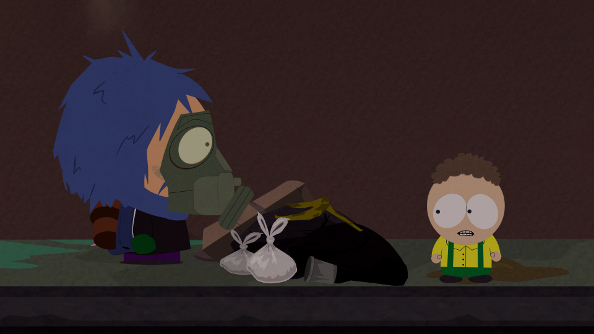
It’s the brilliant, yet utterly offensive, writing that really makes the early part of the game a delight, and the strength of the writing persists throughout. Gags and laughs come thick and fast right from the get-go. From Butters’ pointing out all the places where he was bullied in his typically clueless, cheery way, to Mr. Slave sending you to pick up his sex toy from the Post Office because it got mixed up with Mrs Cartman’s delivery, it doesn’t let up. “We must like the same things,” he said. And yes, they do – as my inventory filled with her vibrators and dildos could attest to.
Almost every object and character exists to elicit a chuckle. Even the junk items that do nothing are visual gags or nods to classic episodes, like a ball of pubes or a badge for the Ginger Separatist Movement. If you’ve watched the show consistently throughout the years, be prepared for Easter Eggs. Many, many Easter Eggs.
The Stick of Truth is clearly a celebration of all that is South Park, of 16 years of episodes. Parker and Stone’s influence permeates throughout it, so much so that it’s easy to forget that it was also designed by RPG vets, Obsidian. That changes after a couple of hours though. Not only is the Stick of Truth a great South Park game, it’s a great game, period.
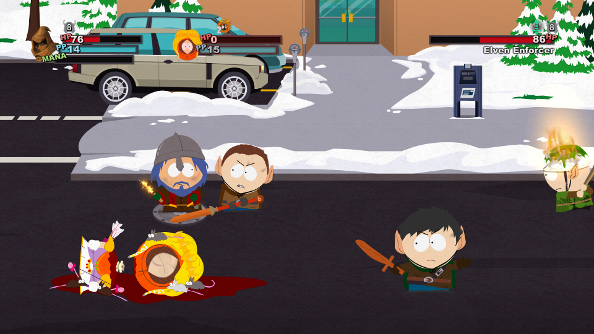
As more items and abilities are introduced, combat becomes a more complex affair. Take my version of Douchebag, who was a rogue. One of his primary abilities, a backstab, caused foes to start bleeding. At first it was handy just because it meant they were taking damage over time, but then I started finding new gear, patches – which could be applied to costumes – and bits and bobs to augment my weapons with.
With the right combination of patches and customised weapons, Douchebag could do extra damage to bleeding enemies, prolong the number of turns they bled for and make the bleeding hurt more. The same could be done for elemental effects and healing. Then there are the “gross” strikes that make foes vomit, also doing damage over time. Working in tandem with the abilities of teammates, from Cartman’s farting fire powers to Butters’ comforting healing, there are a lot of ways to tackle any battle.
Some enemies are immune to certain attacks, or have stances that allow them to reflect ranged or melee attacks, so it’s important to have a big bag of tricks. And rounding out that bag are the gaseous magical attacks, the first of which, “dragon shout”, is a not-so-subtle nod to Skyrim, and it’s far from the only one. Four farting spells can be learned in total, with various effects like stunning enemies, distracting them or grossing them out. And it’s with these spells that you really start to feel like it’s an Obsidian game.
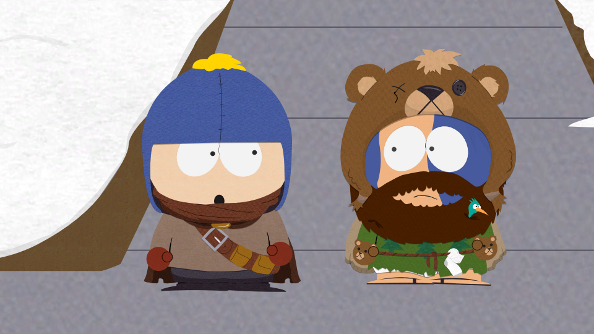
Like Alpha Protocol, Knights of the Old Republic II and Fallout New Vegas, skills that are helpful in battle are equally helpful outside of it. Farting on an open flame, for instance, causes a huge explosion, killing enemies before a fight or even opening up new areas. Throughout the 20-or-so hour adventure, Douchebag learns a lot of new tricks, far beyond farting, that allows him to explore new parts of South Park and beyond. It’s oddly reminiscent of Metroidvania titles, as one discovers shortcuts or secret rooms by using new powers.
And, of course, you can use some of them just to take the piss. There are several achievements for farting on a specific number of people, farting on allies and farting on enemies to avoid battle. Farting is a big part of South Park. But there’s one rule: never fart on a man’s balls. You’ll mainly be using them for exploration, though, because there is a mind-boggling array of loot to find.
Obsidian and South Park Studios have outdone themselves when it comes to character customisation. The initial character creator is extremely robust, but pales in comparison to the cosmetic and practical additions one finds even after just an hour of playing. Want to dress up as Genghis Khan and wield The Staff of Major Boobage (a nod to the Heavy Metal inspired episode)? You can do that; you’d probably look better dressed in Valkyrie boob armour while flailing around with a large pink vibrator, though. You might only be able to play as a boy, but you can certainly dress up as a girl.
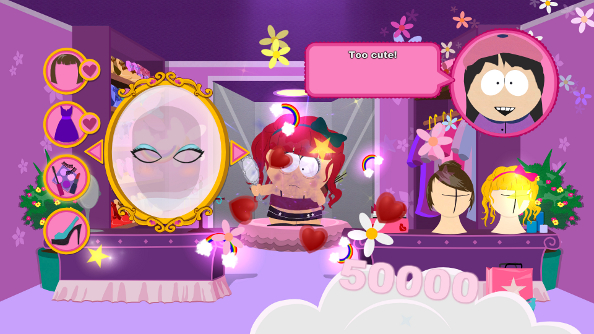
Much of The Stick of Truth is taken up with the lampooning of other games – there’s a whole Zelda-style arc – or the tropes found within them. And there’s not much that is sacred outside of video games, either. Facebook and Twitter (but as Cartman keeps reminding everyone, it’s a “carrier raven”) take a good lashing, and a facsimile of the former serves as the in-game menu. Celebrities aren’t in the least bit safe, either. But it wouldn’t be South Park if it didn’t push the limits of taste. And it might have gone too far for some.
Abortions, pedophelia, religion, racism – they are all tackled with varying degrees of subtlety or complete lack of subtlety. I get the impression that Parker and Stone were playing a game of chicken with video game rating bodies. Characters even mention going too far for PEGI before one of the abortion scenes. In parts of Europe and in the Middle East, Africa and Australia, several scenes have been censored. The UK PC version is uncensored though, and it’s almost certainly one of the most offensive and grotesque games I’ve played. You fight aborted fetuses that have become Nazi zombies. One battle sees Douchebag shrunk down and fighting on the bed his parents are having sex on, and he has to avoid his father’s drooping, swinging testicles.
I laughed, and then often felt terrible, then laughed again. Sometimes there’s a joke or a point being made, but just as frequently The Stick of Truth attempts to shock for the sake of it. It works, however, in that it stays true to the TV series every step of the way. I want to say that it’s essentially a day-long episode of South Park, but that would be ignoring the fact that it’s also a wonderfully designed game. And huge.
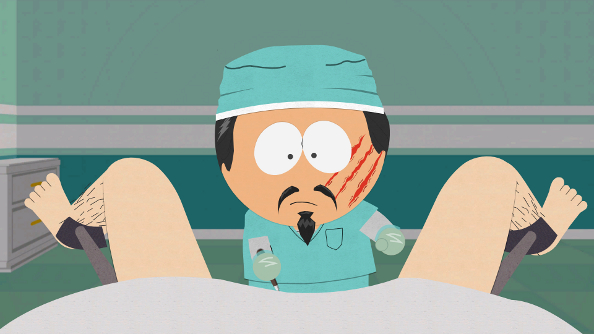
20 hours isn’t very long for an RPG, these days, but The Stick of Truth seems gargantuan. South Park itself isn’t very big, but it’s a Tardis, with expansive levels squashed into the sleepy mountain town. Some of them are mundane, but elevated by the game’s absurdity. A garden becomes a fortress, a house becomes a lively tavern, South Park Elementary becomes a blood-soaked battleground. And within them all reside a bizarre assortment of foes.
Hobos who get “jacked up” by drinking a bottle of bourbon and flinging it, magical hippy elves, sentient blobs of bacteria, rabid animals with a penchant for humping legs, ginger children and Nazi zombie babies, animals, soldiers – it’s an exotic group of villains that Douchebag must defeat. He doesn’t go it alone, of course. There are the aforementioned companions, his friends who can be controlled in battle, but other characters can also be summoned: Jesus with his machine gun, Mr. Slave with his hungry arsehole – gathering these allies is the impetus for a lot of the sidequests.
The Stick of Truth is easy enough so that it could be completed in a fraction of the 20 hours I spent with it. But to do so would be to miss out. There are critters to murder for Jimbo, Chimpokomon toys to collect (gotta catch ‘em all, especially “shoe”), and kids to befriend. Sometimes there’s a tangible reward, like a new perk or item. But occasionally I found myself completing them just because it’s fun. The comedy is the real reward.
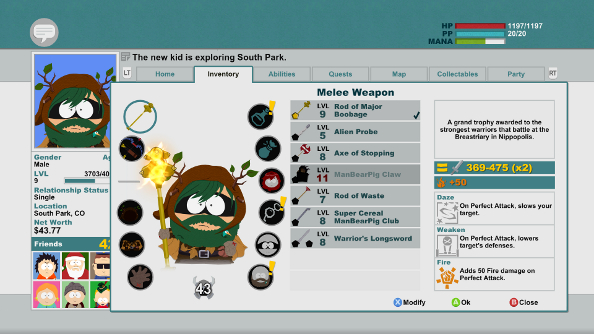
The delays caused by THQ’s bankruptcy and Ubisoft being… well, Ubisoft may actually have been good for The Stick of Truth. Normally, at this point, you’d expect me to list all the ways in which the game is broken, describing all the terrible bugs I encountered. It is an Obsidian game, after all. I’m going to have to disappoint you. I was the victim of one bug. A bug that didn’t occur until the end of the game and had barely any impact. For five minutes, Douchebag flickered a little bit in some cutscenes. That was it. The game really is full of surprises.
South Park: The Stick of Truth feels like it’s been 16 years in the making, drawing on the high points from 17 seasons of lewd hilarity. Kenny dies a lot, and those immortal lines are uttered; Jimmy takes five minutes to spit out a sentence, requiring players to press a button to skip it; and Canada is a weird place containing dire bears, farting comedy duos and queefing women – it’s all there. This is South Park, and Obsidian’s RPG design at their very best.
